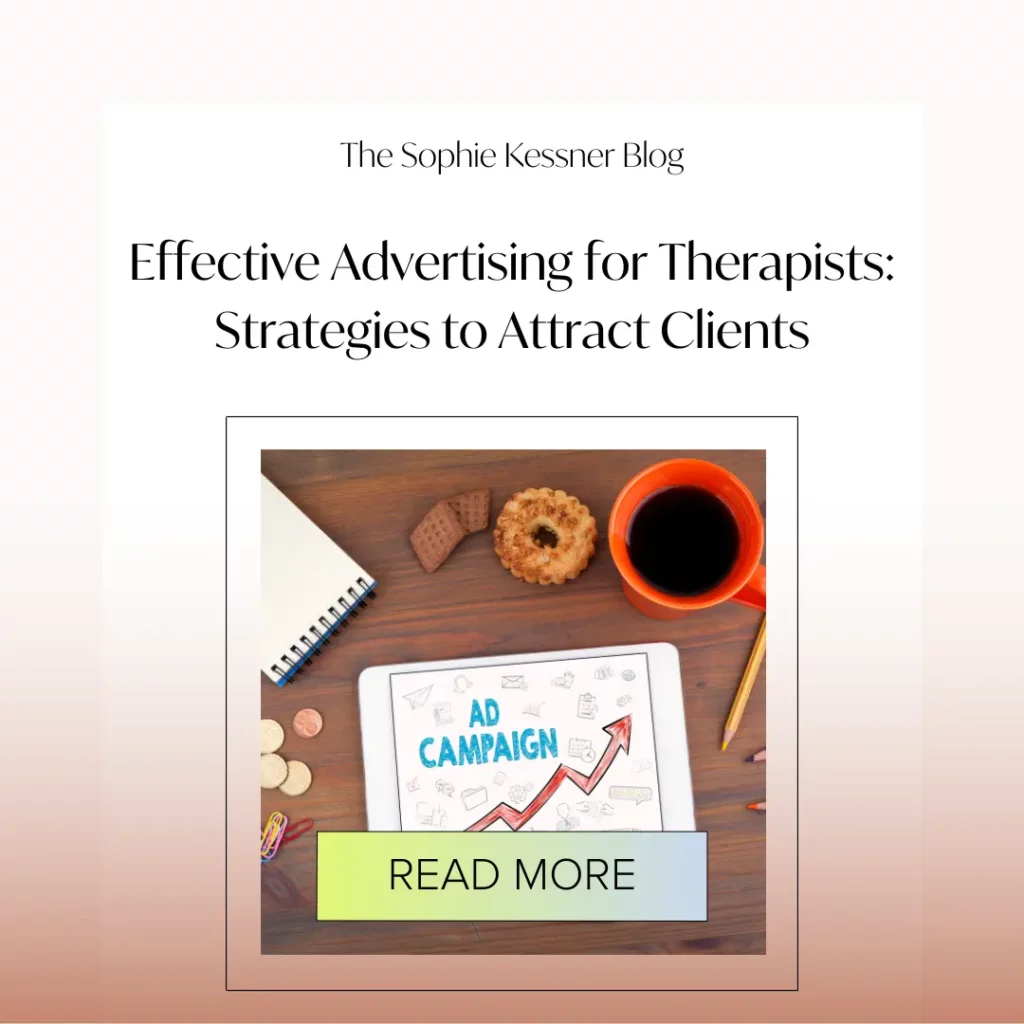If you run a private practice, attracting the right clients is key to your success. Advertising for therapists means more than just posting ads—it’s about creating a marketing strategy that connects you with your ideal client while capturing the audience’s attention and respecting ethical guidelines.
The mental health field is growing fast, with the U.S. behavioral health market expected to reach $132.4 billion by 2027, showing steady demand for therapy services (Source: Precedence Research). This growth brings more opportunities—and more competition—to attract potential clients.
Building a professional website optimized for search engines, using paid ads like Google Ads and Instagram Ads, and sharing helpful content on mental health topics are proven ways to increase online visibility. Growing a referral network with other mental health professionals also helps bring in more clients and strengthen your therapy practice.
Understanding Your Ideal Client
Knowing who your ideal client is makes all the difference in your marketing efforts. Having a basic understanding of marketing is essential for therapists, particularly those with low budgets. When you understand your target audience, you can create marketing materials that speak directly to their needs and concerns. This helps you attract the right prospective clients to your therapy practice.
Start by thinking about the common challenges your clients face. Are they dealing with anxiety, depression, relationship issues, or something else? Consider their age, location, and lifestyle. For example, are you focusing on local clients or offering online therapy services? This will shape your advertising strategy.
Here are a few simple steps to identify your ideal client:
List client characteristics: Age, gender, occupation, and common issues.
Understand their goals: What do they want to achieve through therapy?
Know where they spend time: Online platforms, local communities, or professional groups.
Consider their concerns: What might stop them from reaching out?
Once you have a clear picture, tailor your marketing materials—like your website content, social media bios, and paid ads—to address these points. This focused approach helps you target specific keywords in your SEO and Google Ads campaigns, making it easier for potential clients to find you.
Remember, ideal client identification is not a one-time task. Keep reviewing and updating your understanding as your practice grows and industry trends change. This keeps your marketing efforts relevant and effective.
Developing a Marketing Strategy
A clear marketing strategy is the foundation of successful advertising for therapists. It helps you focus your efforts on reaching the right people—your ideal clients—and makes your marketing efforts more efficient and effective.
Start by setting simple, specific goals. For example, you might want to increase website visits, get more inquiries for a free consultation, or grow your social media presence. Having clear goals helps you measure your progress and adjust your approach as needed.
Next, think about the marketing approach that fits your therapy practice. Consider which online advertising methods work best for your target audience. For many therapists, a mix of search engine optimization (SEO), paid ads like Google Ads and Instagram Ads, and content marketing works well.
Keep these points in mind when building your strategy:
Know your budget: Decide how much you can spend on paid ads and other marketing materials.
Choose the right channels: Focus on social media platforms and advertising channels where your potential clients spend time.
Create helpful content: Share mental health topics that your audience cares about to build trust and attract clients.
Follow ethical guidelines: Always keep client confidentiality and professionalism front and center in your marketing campaigns.
Finally, track your results. Use tools like Google Analytics to see how many people visit your therapy website and how they found you. Monitor your paid ads’ performance and social media engagement. This data helps you refine your advertising strategy and attract more clients over time.
A well-planned marketing strategy isn’t set in stone. It evolves as you learn what works best for your therapy business and as industry trends change.
Setting Measurable Goals
Setting measurable goals is key to tracking the success of your marketing efforts. Instead of vague aims like “get more clients,” focus on clear targets such as increasing website traffic by 20% or booking five new consultations each month.
Use tools like Google Analytics to monitor website visits and see which search terms bring in potential clients. Track engagement on your social media accounts and measure how many inquiries come from paid ads like Google Ads or Instagram Ads.
Regularly review these numbers to understand what’s working. Adjust your marketing campaigns based on data to improve results and attract more prospective clients.
Building a Strong Online Presence

A strong online presence is essential for attracting new clients to your therapy practice. Most people start their search for mental health services online, so having a professional website and good online visibility can make a big difference.
Create a Professional Website
Your therapy website should be clear, welcoming, and easy to navigate. Include essential information such as:
Your therapy services and specialties
Your credentials and experience
Contact details and a simple way to book a free consultation
Client testimonials (while respecting client confidentiality)
Make sure your website content uses keywords your ideal client might search for, like “therapy services in [your city]” or “mental health support online.” This helps your site rank higher on search engines.
Use Search Engine Optimization (SEO)
SEO helps your website show up when potential clients search for therapy services. Focus on:
Using relevant keywords naturally in your website content
Writing helpful blog posts about mental health topics
Ensuring your site loads quickly and works well on mobile devices
Creating clear page titles and descriptions
Leverage Google Business Profile
Setting up and regularly updating your Google Business Profile helps local clients find your practice. Include your address, phone number, hours, and photos. Encourage satisfied clients to leave reviews, which build trust and improve your online visibility.
Combine with Paid Ads
To boost your online presence further, use paid ads like Google Ads targeting specific keywords related to your therapy services. This helps you reach potential clients actively searching for help.
Why It Matters
The online therapy services market is growing rapidly, expected to reach $15.21 billion in 2025 with a compound annual growth rate (CAGR) of 25.5%. This growth means more people are looking online for mental health support, making your online visibility more important than ever.
Building a strong online presence takes time but is one of the most effective marketing strategies for therapists. It helps you connect with more prospective clients and grow your therapy business.
Content Marketing for Therapists
Content marketing is a powerful way to attract potential clients and show your expertise as a mental health professional. By sharing helpful content, you build trust and make it easier for prospective clients to find your therapy practice online.
Including interesting articles in your newsletters can keep readers fascinated and add value to the content shared.
What to Share
Focus on creating content that answers common questions or offers support on mental health topics. Some ideas include:
Tips for managing anxiety or stress
How therapy can help with relationships
Self-care strategies
Explaining different therapy techniques
This kind of helpful content not only draws in your target audience but also improves your search engine optimization (SEO) by including relevant keywords naturally in your website content and blog posts.
Formats to Consider
You don’t have to stick to just blog posts. Try mixing in:
Short videos or reels on social media platforms
Infographics that explain mental health concepts
FAQs addressing common client concerns
Online workshops or webinars
Creating an online course to provide value and generate income
Consistency is Key
Posting regularly keeps your social media accounts and website fresh, which helps with online visibility. It also shows prospective clients that you’re active and engaged in the mental health field.
Build Connections
Sharing content that resonates with your ideal client helps you attract the right people and encourages them to reach out for therapy services. It also supports your paid ads and SEO efforts by providing valuable marketing materials.
Remember, content marketing is a long-term strategy. It may take time to see results, but consistent effort will help you convert potential clients and grow your therapy practice.
Email Marketing and Automation

Email marketing is a powerful tool for therapists to connect with potential clients, share valuable content, and promote their services. By building an email list and creating effective email campaigns, therapists can nurture relationships with prospective clients and encourage them to take action.
Benefits of Email Marketing
Email marketing offers several benefits for therapists, including increased online visibility, improved engagement with potential clients, and enhanced credibility. By sharing helpful content, such as articles, tips, and resources, therapists can establish themselves as trusted authorities in their field. Additionally, email marketing allows therapists to target specific keywords and demographics, ensuring that their message reaches the right audience.
Creating Effective Email Campaigns
To create effective email campaigns, therapists should focus on crafting compelling subject lines, using personalized greetings, and providing valuable content. The email should be concise, easy to read, and optimized for mobile devices. Including a clear call to action, such as booking a free consultation or visiting your website, can encourage potential clients to take the next step.
Automating Your Email Strategy
Automating an email strategy involves using software to schedule and send emails to subscribers. This can include welcome emails, newsletters, and promotional emails. By automating their email strategy, therapists can ensure consistent communication with potential clients, build trust, and increase the likelihood of conversion. Additionally, automation tools can help therapists track engagement metrics, such as open rates and click-through rates, allowing them to refine their email marketing approach and improve results.
By incorporating email marketing and automation into your overall marketing strategy, you can maintain regular contact with prospective clients, provide ongoing value, and ultimately attract more clients to your therapy practice.
Paid Advertising Strategies
Paid ads can be a fast and effective way to reach potential clients actively searching for therapy services. Platforms like Google Ads and Instagram Ads let you target specific keywords and demographics, helping you connect with the right audience.
Why Use Paid Ads?
Many people looking for mental health support turn to search engines or social media to find therapists. Paid ads put your therapy practice in front of these prospective clients when they need it most. Unlike organic methods, paid ads can deliver quicker results and boost your online visibility.
Choosing the Right Platforms
Google Ads: Great for targeting search terms like “therapist near me” or “online therapy.” You can target local clients by setting geographic limits.
Instagram Ads: Ideal for reaching younger audiences and sharing helpful content or promotions like a free consultation.
Facebook Ads: Useful for detailed demographic targeting and building awareness in your community.
Tips for Effective Paid Ads
Use clear, simple language: Focus on how your therapy services can help.
Include a call to action: Invite potential clients to book a free consultation or visit your therapy website.
Target specific keywords: Use terms your ideal client might search for to improve ad relevance.
Set a budget: Start small and adjust based on what works.
Monitor and Adjust
Track your advertising campaigns regularly. Look at metrics like clicks, inquiries, and conversions to see what’s working. Adjust your ads and targeting to get the best return on your investment.
Paid advertising is a valuable part of a marketing strategy for therapists, especially when combined with strong SEO and content marketing. It helps you reach more clients and grow your therapy practice faster.
Social Media Marketing

Social media marketing is a great way to connect with potential clients and build your therapy practice’s online presence. Many people use social media platforms daily, making them ideal places to share helpful content and promote your therapy services.
Choose the Right Platforms
Focus on social media channels where your target audience spends time. For many therapists, Facebook, Instagram, and LinkedIn work well. Each platform offers unique ways to engage:
Facebook: Share articles, client testimonials, and event announcements.
Instagram: Post short videos, mental health tips, and behind-the-scenes glimpses of your practice.
LinkedIn: Connect with other mental health professionals and healthcare providers to build your referral network.
LinkedIn: Network with other healthcare providers, such as primary care physicians or specialists, to create beneficial partnerships that enhance your ability to serve patients effectively.
Create Helpful Content
Share content that addresses common mental health topics and offers support. This can include:
Tips for managing stress or anxiety
Information about different therapy techniques
Updates on mental health industry trends
Using relevant keywords in your social media bios and posts helps improve your online visibility and attracts the right clients.
Engage Consistently
Building a strong social media presence requires regular posting and interaction. Respond to comments and messages promptly to show you care. Use social media marketing tools to schedule posts and track engagement.
Use Paid Ads on Social Media
Platforms like Instagram and Facebook offer paid ads that let you target potential clients by focusing on specific demographics and interests. Running Instagram Ads can help you reach potential clients who are actively looking for mental health support.
When combined with your website and content marketing, social media marketing becomes a powerful tool to attract more clients and grow your therapy business.
Leveraging Professional Directories & Associations
Listing your therapy practice in professional directories and joining national associations can boost your credibility and help attract more clients. These resources increase your online visibility and connect you with other mental health professionals.
Therapy Directories
Sites like Psychology Today and therapy directories specific to your region are popular places where prospective clients search for therapy services. Make sure your profile is complete with up-to-date information, including your specialties, credentials, and contact details. A well-maintained profile helps clients find you and builds trust.
National Associations
Joining organizations such as the American Psychological Association or other national associations provides access to valuable resources. These groups offer guidance on ethical guidelines, marketing approaches, and industry trends. They also provide networking opportunities with other therapists and healthcare providers, helping you build a strong referral network.
Benefits of Professional Listings and Associations
Increase your therapy website’s traffic through directory links
Gain credibility with prospective clients
Stay up to date with changes in the mental health field
Connect with other professionals who can refer clients
Using these tools alongside your digital marketing efforts creates a well-rounded advertising strategy that supports your therapy business growth.
Ethical and Mental Health Considerations
When marketing your therapy services, it’s important to keep ethical guidelines at the forefront. Advertising for therapists must be respectful, professional, and protect client confidentiality.
Respect Client Confidentiality
Never share any client information or stories without explicit permission. Testimonials should be anonymous or generalized to maintain privacy. This builds trust and shows your commitment to ethical standards.
Use Honest Messaging
Your marketing materials should clearly represent your therapy services without exaggeration. Avoid making promises or guarantees about outcomes. Instead, focus on how you support mental health and offer compassionate care.
Be Sensitive in Your Approach
Mental health topics can be sensitive. Use language that is empathetic and supportive. Avoid stigmatizing terms or anything that might discourage prospective clients from seeking help.
Follow Professional Guidelines
Check with your national association or licensing board for specific rules about advertising. Staying compliant protects your reputation and ensures your advertising efforts align with industry standards.
By combining ethical marketing with effective strategies, you can attract clients while maintaining professionalism and respect for the mental health field.
Attracting More Clients
Attracting more clients takes a mix of smart marketing strategies and building strong relationships. Successful marketing is essential for practitioners to effectively connect with potential clients and enhance their visibility. While online advertising and content marketing are important, don’t overlook the power of personal connections.
Build a Referral Network
Connect with other mental health professionals and healthcare providers. They can refer clients to your practice when their patients need specialized therapy services. Attend local events, join professional groups, and stay active in your national association to expand your network.
Encourage Client Referrals
Satisfied clients are often happy to refer friends or family. You can gently encourage this by reminding clients about confidentiality and offering a free consultation for new referrals. Always keep these conversations respectful and professional.
Use Other Marketing Strategies
Consider hosting online workshops or webinars on mental health topics. These free sessions can attract local clients and showcase your expertise. Also, participate in community events or offer to speak at local groups to raise awareness of your therapy business.
Combining these approaches with your online advertising efforts creates a well-rounded marketing approach. This helps you reach more prospective clients and grow your therapy practice steadily.
Measuring Success and Optimizing Campaigns

Tracking your marketing efforts is essential to know what’s working and where to improve. Without measuring success, it’s hard to make the right decisions and attract more clients effectively.
Key Metrics to Monitor
Website traffic: Use tools like Google Analytics to see how many people visit your therapy website and which pages they view.
Search terms: Check which keywords bring visitors to your site—this helps refine your SEO and paid ads.
Social media engagement: Track likes, comments, shares, and follower growth on your social media accounts.
Inquiries and bookings: Monitor how many prospective clients contact you or book a free consultation through your website or ads.
Use Data to Improve
Review your marketing campaigns regularly. If certain ads or posts aren’t performing well, adjust the messaging, audience targeting, or budget. For example, if Google Ads targeting specific keywords isn’t converting, try new keywords or update your ad copy.
Stay Flexible
Marketing for therapists is an ongoing process. Industry trends and client needs change, so your marketing approach should evolve too. Stay up to date by following mental health marketing news and national association updates.
By measuring success and optimizing your campaigns, you’ll make the most of your advertising efforts and attract more clients to your therapy practice.
Staying Up to Date with Industry Trends
The mental health field and marketing strategies are always changing. Staying up to date helps you keep your therapy practice competitive and your advertising efforts fresh.
Follow Mental Health Marketing News
Subscribe to newsletters or blogs focused on mental health marketing. These resources share tips on new marketing tools, social media updates, and changes in search engine algorithms that affect your online visibility.
Engage with Professional Communities
Join online groups or forums for mental health professionals and marketers. These spaces let you share experiences, ask questions, and learn about what’s working for others in the therapy business.
Attend Workshops and Webinars
Look for online workshops or courses on digital marketing and mental health topics. These sessions help you sharpen your skills and discover new ways to reach prospective clients.
Adapt Your Marketing Approach
Be ready to adjust your marketing strategy based on new trends or tools. For example, if a new social media platform gains popularity among your target audience, consider creating social media accounts there.
Keeping your marketing approach current ensures you attract more clients and maintain a strong presence in the mental health field.
Conclusion: Finding the Right Marketing Strategies
Growing a therapy practice takes time, effort, and the right marketing strategies. Advertising for therapists means connecting with your ideal client through honest, ethical, and clear messaging. Using a mix of online advertising, content marketing, and building a referral network helps you reach more prospective clients.
Focus on creating a professional website optimized for search engines and use paid ads like Google Ads and Instagram Ads to boost your online visibility. Sharing helpful content on mental health topics and maintaining an active social media presence builds trust and keeps your audience engaged.
To take your marketing efforts further, consider our DIY SEO course designed specifically for therapists. It empowers you to optimize your therapy website and attract more clients on your own schedule. If you want expert support, our SEO for Therapists service offers tailored strategies to boost your online visibility and convert potential clients effectively.
Ready to grow your therapy business with the right marketing approach? Explore our DIY SEO course or reach out to learn how our SEO for Therapists service can help you attract more clients and build a thriving practice.
Frequently Asked Questions (FAQs)
1. How can SEO help my therapy practice?
SEO improves your website’s visibility on search engines like Google. This means more potential clients can find your services when searching for therapy in your area or online.
2. Is paid advertising worth it for therapists?
Yes, paid ads like Google Ads and Instagram Ads can quickly reach people actively looking for therapy. They complement organic marketing efforts and help attract new clients faster.
3. How do I maintain client confidentiality in marketing?
Always avoid sharing any personal client information without permission. Use generalized testimonials and focus on ethical, respectful messaging to build trust.
4. What type of content should I share on social media?
Share helpful tips, mental health insights, and information about your therapy services. Consistent, supportive content engages your audience and builds credibility.
5. How often should I update my marketing strategy?
Regularly review your marketing efforts—at least every few months. Adjust based on performance data and stay updated with industry trends to keep your strategy effective.





